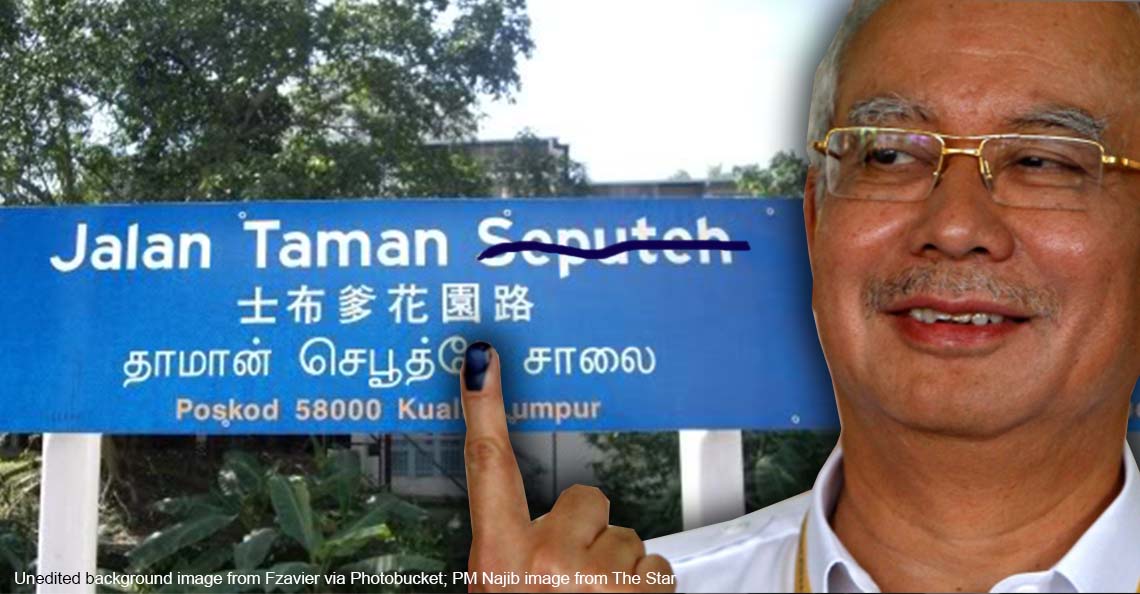The Selangor government might have just saved Peninsula Malaysia from electoral fraud. Here’s how.

- 5.3KShares
- Facebook4.9K
- Twitter32
- LinkedIn50
- Email74
- WhatsApp227
Have you registered as a voter? If you have, chances are you’ve heard of the Electoral Committee (EC), or the Suruhanjaya Pilihan Raya (SPR) in BM. Recently, there has been an uproar over the EC’s efforts in redelineating the electoral districts of Sabah, Sarawak and the Peninsular Malaysia, with most parties reacting negatively to the news.
So the Selangor gomen and few other states started making ALOT of noise, including a law-suit, and now it seems that they might have found a legal hangup that prevents the EC from changing any lines in the whole of Peninsula Malaysia! YAY!
Story over!

…..
Except… what in the name of all that is good and holy is this redelineating thingamajig?
PS: More about Sabah and Sarawak later 😉

First, it’s helpful to know that the EC basically has three main functions:
- Handling the registration of voters and the checking of a voter’s status;
- Carrying out General Elections for the Dewan Rakyat (House of Representatives) and the Dewan Undangan Negeri (State Legislative Assemblies), as well as small elections if there is an opening in any of these positions; and
- Conduct studies as well as the delineation of Parliamentary and State Election Divisions at most once in every 8 years.
In simple terms, the EC divides Malaysia into little parliamentary constituencies (currently 222) and state constituencies (currently 587)), and each voter from these constituencies will choose ONE member of the Dewan Rakyat (on the national level), or Member of the Parliament (MPs) and ONE ADUNs, or Ahli Dewan Undangan Negeri (on the state level). This process of dividing up the areas is called ‘delineation‘, but some may also call it ‘boundary delimitation‘.
And these lines aren’t drawn with permanent marker – they can be changed at most once every eight years. This process of redrawing boundaries is called ‘redelineation‘, and is meant to create a fairer system, taking into account population growth and movement. Since the first delineation after Malaysia came into being, the EC had redelineated Sarawak and Sabah six times, and they are currently trying to do the same for the Peninsular.
While the EC had stated on their website that redelineation exercises are meant to ease the governing of future elections as well as making voter registration easier, some aren’t terribly happy with it. Why? Well…
Redelineation can seriously affect the outcome of an election
If you kept track of previous elections, you might have heard of parties or candidates “winning the popular vote but losing the election“. This is because of the way voters are distributed, in Malaysia, across the 222 seats. Not all seats have the same amount of voters, or the same balance of opposition to BN supporters.
When you’re delineating an area, you’re basically dividing and redistributing voters. And if you know what you’re doing, you can use that to your advantage. There are two common ways delineation can be used to a certain party’s advantage, and they are gerrymandering and malapportionment. But wait! Don’t close that tab just yet, because this video can pretty much sum it up. We shot it for BERSIH way back in 2015, but then BERSIH 4 happened, and they didn’t end up using it 🙁
In case you prefer to read, gerrymandering is the practice of manipulating voting boundaries in order to give an advantage over a party. The ridiculously named term comes from a politician back in the 1800s called Governor Gerry, who contorted the district boundaries in his area to give him an edge in the next elections. One of his weirdly shaped districts looked like a salamander, so newsmen at that time combined his name with the salamander, giving us the word – gerrymander.
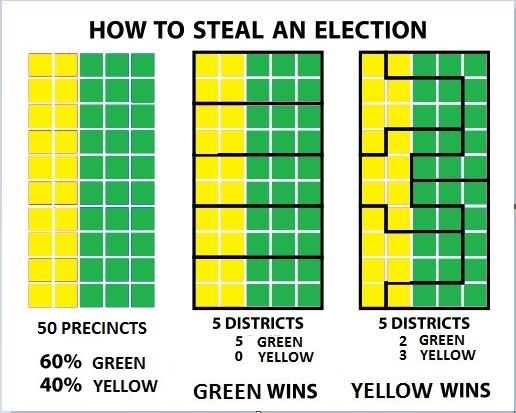
Gerrymandering can be used in two ways:
- Packing, where an opponent’s voters are concentrated in a few districts so that winning in all the other districts is more likely, and
- Cracking, where an opponent’s strong area is divided and combined with your strong areas, reducing their voting power.
Malapportionment, on the other hand, is tampering with the ratio of voters to districts. You might think that ideally all districts should have the same amount of voters? However, because of the world we live in, where some areas are more populated than others, people still need to have some degree of control over their fate – yes, a small district in Sabah deserves a voice, but how much of a voice? That’s where apportionment comes in. Malapportionment is intentionally making small districts, especially in rural areas where a small group of voters might be more easily swayed.
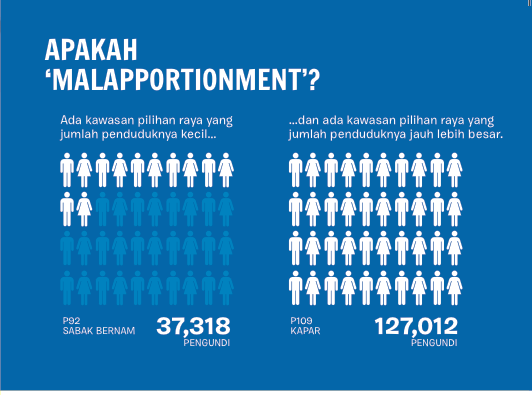
For example, in Malaysia, the district of Kapar has 144,159 voters, and Putrajaya has only 15,791 but they each control one seat in Parliment. In simple terms, this means that a voter in Putrajaya are almost 10 times more influential than a voter in Kapar.
While discrepancies are normal in some countries, for population differences, most countries max out at 4 times difference in voting power – not 10 times as shown above.
Which probably explains why…
Malaysia’s Electoral Committee doesn’t really have a good reputation

The body regulating elections in Malaysia isn’t well-known for its transparency. The Electoral Integrity Project, a US-based independent academic project that basically studies… electoral integrity, had determined that the EC in Malaysia deserves a low, low score of 35 for its PEI 5.0 (Perception of Electoral Integrity).
That puts us fourth from the bottom of the list of 28 countries for the Asia-Pacific region, but hey. We’re slightly better than Vietnam, Cambodia and Afghanistan. For comparison, India, with all their movies of rogue policemen fighting corrupt politicians, has a score of 53. The countries perceived to have the most fair, transparent elections are Denmark and Finland, with a score of 86.
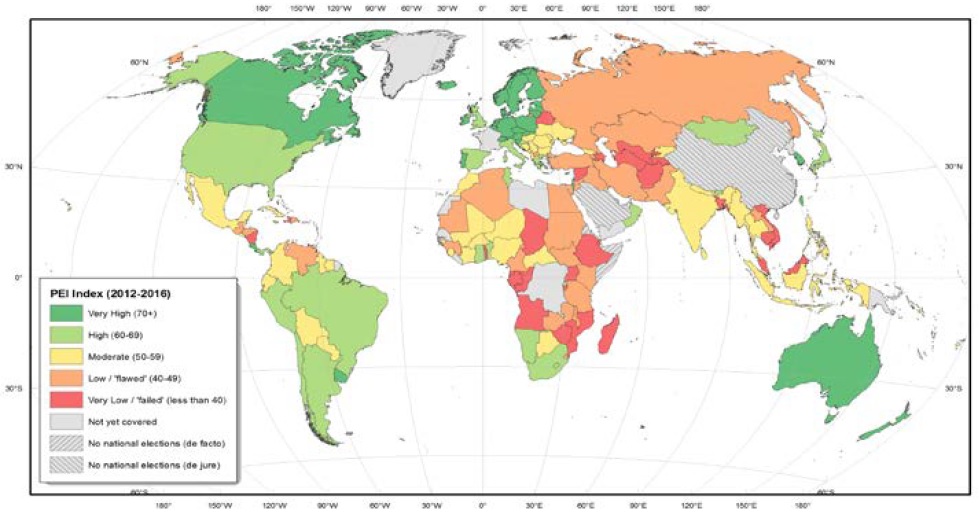
As to why Malaysia ranks so low, we can look at the malapportionment problem first. There are nine times more voters in the Kapar seats in Selangor than there are in Putrajaya, but both are represented by one MP each. And this is not an isolated incident. While on the international level the number of voters usually differ by 10 to 15% between constituencies, the difference in Malaysia may reach hundreds of percent. When the difference is significant, it means that some voters will have more value in their vote than others.
But it wasn’t always that way. Originally, the Federal Constitution limited the difference to no more than 15% between states, but as time goes on the difference was allowed to go as high as 33%. Then somewhere along the line the limit was taken out altogether.
As for gerrymandering, suffice to say that although BN won only 47% of the votes from the last GE, they managed to get 60% of the 222 parliamentary seats. Not saying that the BN somehow managed to convince the EC to redraw the lines in their favor or anything. Maybe they got lucky. We might never know.

Gerrymandering and malapportionment aside, there is another thing that can be achieved through delineation: creating new voting districts. Back in 1965, the Malaysian parliament had only 144 seats. Now there’s 222. While the increase in seats had been attributed to an increase in population, Penang Institute fellow, Dr Wong Chin Huat feels that this shouldn’t be so.
“They are two separate processes. The whole idea of redelineation is not for you to create new seats. The EC is supposed to redelineate based on the existing number (of legislative seats) but they are doing it the other way around,” – Dr Wong Chin Huat, Penang Institute fellow in an interview with Sunday Star.
Dr Wong argued that while a redelineation proposal would only require a simple majority of votes in the Parliament, a seat increase proposal calls for an amendment of Article 46 in the Federal Constitution, which two-thirds of the Parliament to agree on the change, making the adding of new seats an unconstitutional practice.
So yes, this is why Selangor sued the EC. But what about Sabah and Sarawak?

The redelineation move was not taken well by several states and voters in the Peninsular. On their first round of local inquiry on the Peninsular states, the EC heard 425 objections. These objections aren’t just one guy who bantah – Each objection needed to come from “state governments, local authorities and groups of 100 people or more, whose names are in the electoral rolls”.
There was also a significant number of people and states who challenged the redelineation exercise in court, and that list includes 2 MPs and 3 voters from Perak, 7 voters from Malacca, 4 voters from Johor, as well as the Penang state government.
However, Selangor’s case seemed to be the most notable at the moment, and the case stretched back to mere weeks after the EC announced the redelineation move. Since then, the court had frozen local inquiries on Selangor following them suing the EC to invalidate the redelineation proposals.
Section 8 in the 13th Schedule of the Federal Constitution had stated that the EC “shall submit its report on the redelineation exercise to the prime minister after it has completed the inquiries for all 11 states in the peninsula”, and the High Court had allowed Selangor to prevent the EC from submitting its delineation report on the grounds that the EC had not disagreed with the state’s interpretation of that section.
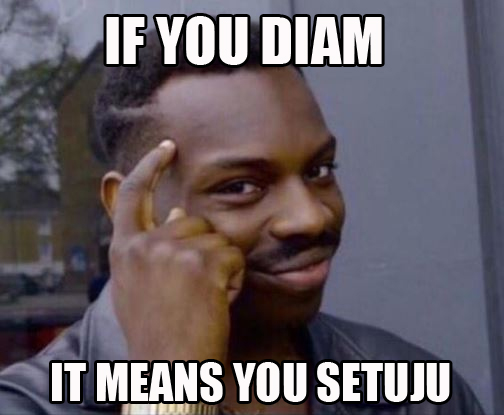
The 7 voters from Malacca, on the other hand, managed to stop the EC from doing their local inquiries in Malacca, by declaring that the second round of EC proposals are invalid and unconstitutional for several reasons, among them the omission of Selangor and a defective electoral roll that excludes the addresses of some 44,190 Malacca voters.
These developments have a good chance from preventing the delineation from being effective for the next election, as the time limit set forth by the constitution for a redelineation exercise is two years from the date of which it was gazetted, which makes the deadline for the EC to submit that report is by September 2018.
It’s also worth noting that the report whose submission is prevented is a crucial part of the entire delineation process. Without the prime minister receiving the report, it won’t be tabled in Parliament for approval, and changes such as redrawing the electoral boundaries can’t be officially done.
Since the next General Election must happen before the 24th of August, 2018, the chairman of the EC, Mohd Hashim Abdullah, had stated that they will use the unrevised electoral boundaries and names should they not make it. However, he had also stated that certain parties’ assumption that they have prevented the EC from delineating is inaccurate. This is because the court had only prevented them from submitting the report to the prime minister.
TLDR: the lines MIIIGHT not change in time for GE14
Oh and as for Sabah and Sarawak? Remember what we said about redelineation every 8 years? Well Sarawak was redelineated back in 2015, and Sabah was redelineated last year. What’s interesting was that the EC originally submitted a plan for redelineation, which didn’t really received alot of attention. In the whole of Malaysia, 836 objections were received, but only a small number of those were for Sabah. Despite the lack of objections, the EC did take a look at a few of those submitted, and made some changes to their proposed redelineation . We asked BERSIH about these changes and here are their comments.
“There were only extremely minor changes between the first and second display for Sabah. Some constituencies had name changes and, apart from that, the voting totals only changed in 6 DUN seats (no changes in Parliament seats between 1st and 2nd display).” – BERSIH
Speaking of BERSIH, they played a large part in organising these objections, and collecting signatures for objections, which at least in this case, and to some extent, Selangor, have contributed in a more watchful eye over Malaysia’s EC.
So if you’re looking to keep an eye on the EC yourself, BERSIH’s electoral watchdog arm, DART, is looking for objectors to Selangor’s own redelineation right now as well. Sign up here!
- 5.3KShares
- Facebook4.9K
- Twitter32
- LinkedIn50
- Email74
- WhatsApp227



